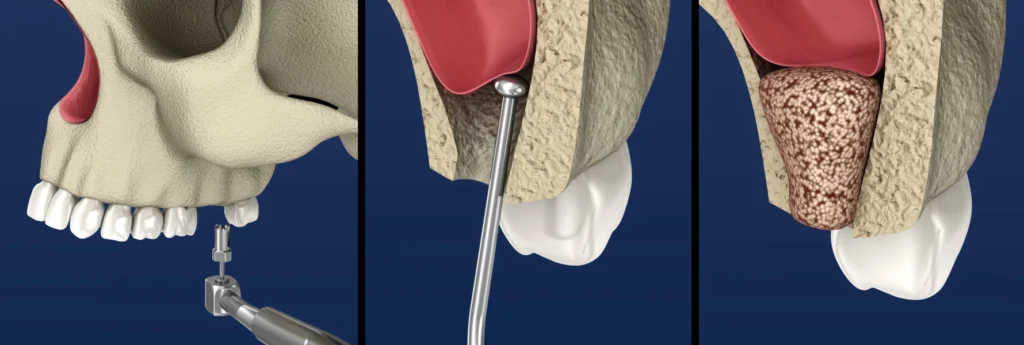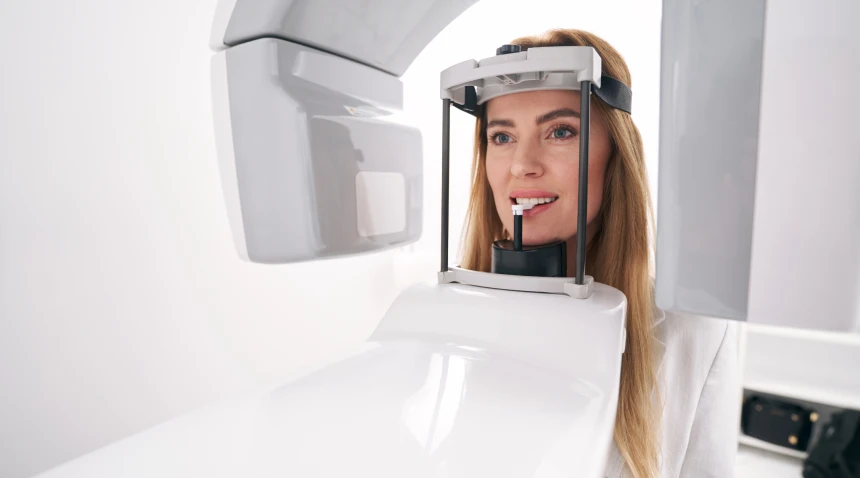The sinus lift, also known as sinus augmentation, is a surgical procedure designed to increase bone volume in the upper jaw, particularly in the molar and premolar areas. This region lies just beneath the maxillary sinus — a natural cavity lined with a delicate membrane. When bone height is insufficient, it becomes impossible to place a dental implant securely. The grafting procedure adds a filling material that gradually integrates with the existing bone, creating a strong and stable foundation for a future implant.
Several situations may make this procedure necessary. The long-term absence of a tooth often leads to bone resorption. Periodontal disease can also weaken the supporting bone, while facial trauma may damage the jaw structure. In some patients, the natural anatomy of the upper jaw provides limited bone height from the outset. In all these cases, the sinus lift helps restore optimal conditions for placing a stable and long-lasting dental implant.

Why bone loss occurs in the sinus area
In the posterior region of the upper jaw, the bone is more porous than in other areas, which makes it resorb more quickly after a tooth extraction. Over time, this loss increases and may make implant placement impossible. In addition, the maxillary sinus can gradually descend with age or after an extraction, further reducing the available bone height.
Other factors can also explain bone deficiency. Periodontal disease progressively destroys the supporting tissues, while fractures or trauma can alter the bone structure. Finally, some individuals naturally have limited bone height, even without any dental history. Therefore, each patient must undergo an accurate diagnosis before considering a sinus graft.
The different stages of a sinus lift
The sinus lift follows a precise multi-step protocol. Each phase plays an essential role in the success of the treatment. The dentist carefully plans the procedure according to the patient’s anatomy and overall health. This preparation minimizes risks, promotes healing, and ensures long-term stability.
The process typically includes diagnosis, site preparation, sinus access, membrane elevation, graft placement, closure, and healing. These steps follow a logical sequence to create ideal conditions for implant placement — either immediately or after bone consolidation.

Preoperative assessment
Diagnosis begins with a comprehensive clinical examination and a 3D cone beam scan. This imaging evaluates bone height, identifies anatomical structures, and checks the sinus membrane’s condition. It also helps anticipate potential challenges. During this phase, the dentist explains the procedure, necessary precautions, and expected healing times.
Accessing the sinus
The procedure is usually performed under local anesthesia, sometimes combined with conscious sedation for greater comfort. The dentist makes a small incision in the gum, exposes the bone, and creates a calibrated opening to reach the sinus floor. This step requires precision and control to avoid damaging nearby structures.
Lifting the sinus membrane
Beneath the bone wall lies the Schneiderian membrane, which lines and protects the sinus. The dentist carefully lifts this membrane to create space for the graft material. This step must be done delicately to avoid tearing the membrane; if a tear occurs, it is repaired before continuing the procedure.
Placement of the graft
The created space is filled with a grafting material. Depending on the case, this may be autogenous bone (from the patient), purified animal bone, or synthetic biomaterials. The choice depends on the required volume, medical history, and treatment protocol. The goal is always the same: to stimulate bone regeneration and create a reliable foundation.
Closure and healing
Once the graft is placed, the area is closed with suitable sutures. Healing begins immediately, as the bone gradually regenerates and fuses with the graft. Depending on the case, implant placement occurs between four and nine months later.
Postoperative care and follow-up
In the days following surgery, certain precautions are necessary. Patients should avoid blowing their nose forcefully, engaging in activities that increase sinus pressure, or sleeping completely flat. Prescribed medications, usually pain relievers and sometimes antibiotics, help prevent discomfort and infection.
To ensure optimal healing:
- Maintain gentle but thorough oral hygiene, avoiding direct brushing of the treated area.
- Use an antiseptic mouthwash if prescribed.
- Attend all follow-up appointments to monitor healing and graft integration.
- Immediately report any unusual pain, swelling, or prolonged bleeding.
These simple yet essential steps promote proper recovery and reduce the risk of complications.

Simultaneous sinus graft and implant placement
In some cases, the graft and implant can be placed during the same procedure. However, this requires sufficient bone height to stabilize the implant immediately. While this approach shortens the overall treatment time, it demands careful evaluation to avoid long-term stability issues.
Risks and possible complications
As with any surgical procedure, a sinus lift carries some risks. The most common include membrane perforation, infection, partial graft resorption, or prolonged discomfort. In rare cases, patients may experience sinus pressure or temporary congestion.
Thorough planning and adherence to postoperative instructions greatly reduce these risks. Regular follow-up appointments also help detect and manage any issue promptly.
Preoperative preparation
Successful bone grafting also depends on careful preparation. The dentist first treats any cavities or inflammation. Chronic conditions such as diabetes must be well controlled, and smoking should be stopped or reduced, as it delays healing.
A preoperative consultation allows the dentist to explain the procedure, clarify instructions, and answer questions. This discussion builds trust and helps reduce stress before surgery.
Sinus lift FAQ
- Is a sinus lift painful?
No. Local anesthesia prevents pain during the procedure. Afterward, mild discomfort or pressure may occur but usually subsides within a few days with prescribed medication. - How long does healing take?
Healing takes several months. Depending on the case, the implant is placed four to nine months after the graft. - Can I return to normal activities quickly?
Yes, most patients can resume normal activities the next day, avoiding strenuous effort or actions that increase sinus pressure for a few days. - Is the result long-lasting?
Yes. When the graft integrates properly and oral hygiene remains excellent, the results are durable. Regular dental check-ups ensure long-term success.
Book an appointment for a sinus lift
If you are considering a sinus lift or would like to explore your options, a personalized consultation will provide a clear diagnosis and tailored treatment plan. The cabinet dentaire Mirabeau in Paris 16 welcomes each patient with care and offers comprehensive follow-up. Book your appointment online today to prepare for your treatment with confidence.
You may also like: All-on-4